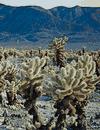- cholla
-
/chohl"yah, -yeuh/; Sp. /chaw"yah/, n., pl. chollas /chohl"yahz, -yeuhz/; Sp. /chaw"yahs/.any of several spiny treelike cacti belonging to the genus Opuntia, esp. O. fulgida of the southwestern U.S. and Mexico, having knobby outgrowths and yellow spines.
* * *
Any cactus of the genus Opuntia, native to North and South America, having needlelike spines partly enclosed in a papery sheath.Chollas vary greatly in size and have small flowers, sometimes chartreuse and inconspicuous, but usually of more striking colors. O. leptocaulis, the desert Christmas cactus, bears bright red fruits through the winter. Living plants serve as food for desert animals. Cholla wood, a hollow cylinder with regularly spaced holes, is used for fuel and novelties. Some cholla fruit is edible. Jumping cholla (Opuntia bigelovii)Grant Heilman
Jumping cholla (Opuntia bigelovii)Grant Heilman* * *
▪ plantany cylindroid-jointed cactus of the genus Opuntia, family Cactaceae, native to North and South America. Chollas vary in size, from the small O. pulchella, which is almost never noticed except when blooming, to small trees about 3 m (10 feet) in height.They have small flowers, sometimes chartreuse and inconspicuous, but more commonly of more striking colours. At least three species—O. pulchella, O. imbricata, and O. whipplei—are hardy to -18° C (0° F) or below. O. leptocaulis, the desert Christmas cactus, holds its bright red fruits through the winter. Eve's pin cushion (O. subulata), found in South America, has large leaves for an Opuntia; they are awl-shaped, grow to 12.5 cm (5 inches) long, and last much longer than the usual few weeks.The living plants serve as food for desert livestock, and cholla wood, a hollow cylinder with regularly spaced holes, is used for fuel and novelties. Some cholla fruit is edible.* * *
Universalium. 2010.
